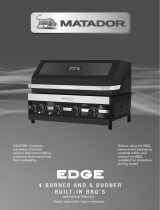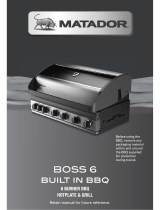•Do not leave food unattended on the BBQ.
•In case of afat fire turn gas off at cylinder immediately.
•Particular care must be taken when removing the fat drip tray. Hot fat can cause serious
burn injuries.
•Proper clearance from combustible materials must be maintained at all times. The
minimum clearances is as follows: Side: 1 metre Rear: 1 metre Ceiling: 1 metre.
•Turn off all gas valves including cylinder after use.
•Do not allow build up of unburned gas.
•Cool the BBQ before replacing the lid or cover.
•Accessible parts maybe very hot. Always keep children away from the BBQ.
•Always wear protective gloves when handling hot components.
•Never lean over BBQ when lighting.
•Never use BBQ with any cover on.
•Never dismantle control valves.
•Never modify the construction of the BBQ or the size of any burner, injector orifice or any
other components. This will void your Warranty.
•Never move the BBQ during use.
•The use of unauthorised parts will void your Warranty and can create an unsafe
environment and conditions of use.
•Never use charcoal or any other solid fuel in this BBQ.
•Never disconnect any gas fittings while the BBQ is in use.
•In the event that a burner goes out and gas escapes, turn off the burner knobs, open the
BBQ hood fully and let it air out. Wait 5 minutes before attempting to relight the BBQ.
•Never let clothing, pot holders or other flammable materials come in contact with or close
to any grill, burner or hot surface until it has cooled. Fabric may ignite and result in personal
injury. Certain materials or items, when stored under or near the BBQ, will be subjected to
radiant heat and could be seriously damaged.
•Clothing or other combustible materials should not be hung from the BBQ, or placed on or
near the BBQ. Combustible materials are considered to be wood, compressed paper, plant
fibres, plastic or other materials capable of being ignited and burned.
Safety Guide Page 9























